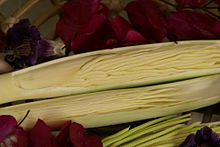Chamaedorea tepejilote
| Chamaedorea tepejilote | |
|---|---|

| |
| Pacaya palm (Chamaedorea tepejilote) taken at Atitlán Lake in Guatemala | |
| Scientific classification | |
| Kingdom: | Plantae |
| Clade: | Tracheophytes |
| Clade: | Angiosperms |
| Clade: | Monocots |
| Clade: | Commelinids |
| Order: | Arecales |
| Family: | Arecaceae |
| Genus: | Chamaedorea |
| Species: | C. tepejilote
|
| Binomial name | |
| Chamaedorea tepejilote | |
Chamaedorea tepejilote, also known as the pacaya palm, is a species of Chamaedorea palm tree found in the understory of the forests of southern Mexico, Central America, and northern Colombia.[2]

Uses
The immature male inflorescences of the plant are considered a delicacy in Guatemala and El Salvador. The unopened inflorescences resemble an ear of corn in appearance and size.[3] Indeed, the word tepejilote means "mountain maize" in the Nahuatl language and was selected because of this resemblance.[2] The common name pacaya, referring to both the plant and its edible flowers, could be derived from the Pacaya volcano.[2]
Pacaya has a somewhat bitter taste, although less so in cultivated varieties.[2] It is eaten in salads (especially fiambre, a salad traditionally eaten in Guatemala on the Day of the Dead) or covered in egg batter and fried.[4] The latter dish is called envueltos de pacaya, and is often served with tomato sauce, like chiles rellenos.
References
- ^ "Chamaedorea tepejilote". Germplasm Resources Information Network. Agricultural Research Service, United States Department of Agriculture. Retrieved 2013-08-27.
- ^ a b c d Castillo Mont, Juan José; Gallardo, Negli Rene; Johnson, Dennis V. (1994). "The Pacaya Palm (Chamadorea Tepejilote; Arecaceae) and its Food Use in Guatemala". Economic Botany. 48 (1): 69. doi:10.1007/bf02901383.
- ^ Cook, Orator Fuller (31 December 1910). "History of the Coconut Palm in America". Contributions from the United States National Herbarium. Bulletin of the United States National Museum. 14 (2): 311. Retrieved 29 August 2013.
- ^ Pieroni, Andrea (2005). Prance, Ghillean; Nesbitt, Mark (eds.). The Cultural History of Plants. Routledge. p. 33-34. ISBN 0415927463.
